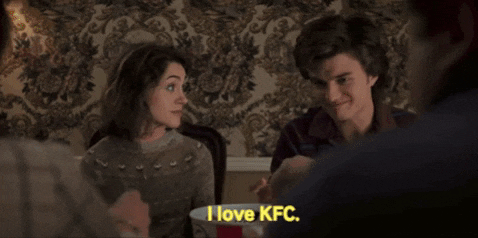
Naming your company is not about the do's and don'ts. It's about thinking outside the box and keeping an open mind.
Your Name is Important
Among the many things we do here at Thoughtlab, we’re often asked to help name or rename a company. Now, the name of your company is very important, it’s how people find you on the internet, how they reference you when they tell their friends, it’s the perfect pairing with a handshake and a hello. The name, if chosen right, can sometimes become eponymous for the product like Q-tips for cotton swabs, or Kleenex for facial tissues. So, the name is very important.

It can be catchy and quirky, making it stay in the customer’s mind, it can also change and get stronger depending on the zeitgeist of the times. Kentucky Fried Chicken has been around for a long time but now, they’re commonly known as KFC. This sheds the notion that they are singular to Kentucky while grabbing onto the way language, due to the internet, texting, and tweeting gets naturally truncated making it easier to convey over different modes of communication. “Let’s get some KFC” is easier to text than, “Why don’t you pick up some Kentucky Fried Chicken for dinner tonight.” Same name, just adjusted for the times.
The Do's and Don'ts
When I sat down to write this blog, I did my research and consulted my notes from naming sessions I was part of here at the lab. I had intended to do one of those “10 Things to Remember” or “10 Things Not to Do When You’re Naming Your Company”. I’m sure you’ve seen blogs or articles covering these subjects and it would have been easy to cull all that information, add my own thoughts and write that blog. But, I won’t.
If you want help with naming rules, I suggest you google it and read some of those articles. Yanik Silver wrote a good one for Entrepreneur, Seven Tips for Naming Your Business and Richard Harroch has an excellent article in Forbes covering the subject titled; 12 Tips for Naming Your Startup Business. Both of these articles are written by smart men, with great experience and they’ll give you the solid dos and don’ts. If that’s what you’re looking for. I’m not going to do that.
Thinking Outside the Box
Recently I wrote a blog for our page about the idea of thinking outside the box. In it, I discussed the idea that trying to think outside the box actually puts you in the box and I gave some suggestions as to how to wake up your mind and expand your choices. Most of what I wrote about in that article are games and exercises I was taught and I use as an actor. Ways to get around the internal editor and learn to say yes to offers made by other actors on stage. Well, I want to continue with those ideas, the thinking beyond the confines of the box, with this blog about naming your business.
If you read articles about the hows and how nots of naming a company and you're sticking doggedly to them, what you’re doing is dropping yourself back into the box, which you’ll then spend more time trying to figure out how to think outside of than you will on naming your company. The rules are good, but they should be viewed merely as guidelines more than rules you must follow.

One of the things I have learned about being a good actor is that it involves being a good filter. You work with actors who are trained in various ways and believe various things. I’m sure we’ve all heard about “The Method” a technique developed by Constantin Stanislavski at the Moscow Art Theater in 1909, it was the birth of what we know as Theater of Realism. How the method translated to the United States caused a divide in some of the more well-known training studios in New York. Stella Adler and her friends saw the method one way and Lee Strasberg went another. From them came Meisner, Uta Hagen and a whole bunch of other ideas on acting.
Some actors are very precious about how and who they follow and they’re very willing to tell you. I found that one single “method” isn’t always applicable and I have developed a combination of techniques that I apply at various times, I have, as an actor, become a good filter. I hold on to what works, what makes sense, what I can apply and make work and the rest, I let pass by. I advise you to apply this idea to your work in any creative endeavor, like naming a company.
When you sit down to name a new company for yourself or for someone else, reading all the rules can lock you into a mindset that may limit your imagination. Anything that brings you closer to the box, into any vicinity of the box, is not going to be helpful at all. Remember, the box is not your creation so thinking outside of it is not your problem. Reading rules on naming and believing them too stringently is simply dropping you into yet another box. Start far from the box. If you read an article about naming, do not sit down the same day and try to name the company, the “rules” will still be too close to you. Take time away before you start so you’re clear.
The Power of Yes
Start with a yes session. Yourself or the people you’re working with, a whiteboard, a marker and the banishment of the word no, in any form. That means no one in the room or you in your head, can say no, can say; “I don’t think that…” or “That isn’t right” or “I can’t see that…” None of those are allowed, all you can do is put an idea on the board and say yes. Even the things that some articles identify as “must nots” should go up on the board. Just say yes to all of it. Do that for about half an hour. Then step away. Now, your mind is open and moving. When you come back try all the names you want. Put adjectives together with nouns, use the names of obscure Greek or Norse Gods, use your well-learned high school Latin, try it all. Don’t say no
Here’s the thing, when you start out with this kind of session, your mind is looking for the “right” answer. You want to have the answer, solve the problem, be the hero, so your initial thoughts are going to be cautious and a little too self-aware. Once you starting putting any and all ideas on the board, your mind relaxes and says, wow, we’re getting a yes all the time, what else do we have in here? Then, the real freedom, the real creativity starts to flow. We naturally fear looking silly, foolish or having the “dumb” idea. If you truly set up a place where there are no dumb ideas and everything is receiving a yes, you will be amazed by what your mind comes up with.

Some Final Thoughts
There are a few things you really do need to do: say the names out loud, say them in sentences and check them at USPTO.gov or on a site called Trademarkia.com to see if the name is available. Don’t fall in love with “your names” the ones you added to the board. Allowing a name to be whittled away is not a failure, taking this personally is putting you back in the box. Also, think about how you’re approaching this task, it does make a difference. If you think, “this is great we get to name this company” as opposed to, “oh my God we gotta name this company”, you’re starting out on a positive and it is much easier to be creative when you’re working from a positive.
The perfect name is there somewhere, making sure you’re listening to yourself and to your co-workers, saying yes, trying everything, makes finding the perfect name easier. It’s akin to what Michelangelo said when asked how he carved the David. Michelangelo said; “I just chipped away the parts that weren’t David.” The yes sessions help you chip away the parts that aren’t the name. Stay away from the box, stay in sight of your innate creativity and you’ll be happier.

